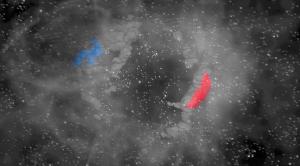Blog
A Supersized Supershell
25 September 2021
 Alyssa Goodman/Center for Astrophysics | Harvard & Smithsonian
Alyssa Goodman/Center for Astrophysics | Harvard & SmithsonianStar formation is a topic astronomers are still trying to fully understand. We know, for example, that stars don’t form individually, but rather are born within vast interstellar molecular clouds. These stellar nurseries contain gas dense enough for gravity to trigger the formation of stars. In spiral galaxies, these molecular clouds are most commonly found within spiral arms, which is why stars are most often born in spiral arms.
We can observe several of these molecular clouds in our local neighborhood of the Milky Way. The most famous one is the Orion nebula, which is part of the Orion Molecular Cloud Complex, but there are other well-known molecular clouds, such as the molecular clouds of Perseus and Taurus. We can see stars forming within these clouds.
One part of the story we don’t fully understand is how these dense molecular clouds form in the first place. Since they are often found along spiral arms, one idea is that they form within pressure waves along the arms as stars bunch up like a traffic jam. Another idea is that their formation is triggered by supernovae. These massive explosions create shockwaves in interstellar gas and dust, causing them to bunch together. But proving this idea is hard because it’s extremely difficult to pin down the location of a molecular cloud. We can see where it is in the sky, but determining the distance is difficult. But a new study has pinned down the locations of the Perseus and Taurus clouds, and the result supports the supernova model.1
 Jasen Lux Chambers/Center for Astrophysics | Harvard & Smithsonian
Jasen Lux Chambers/Center for Astrophysics | Harvard & SmithsonianUsing data from the Gaia spacecraft, the team was able to map the Perseus and Taurus molecular clouds in 3-D. They also mapped other, fainter clouds in the region, and found they were all part of a single structure. They all lie along the surface of a bubble about 500 light-years across. The spherical structure is very clear, and the team has even created an augmented reality version you can check out. Based on the structure of the bubble, the team estimates it was formed by a large supernova or series of supernovae that occurred about 10 million years ago. The clouds we see now, and the stars forming within them, are the result of supernova shock waves.
This work shows that supernovae can play a significant role in the formation of stars, beyond their contribution of heavier elements. With 3-D maps such as this one, we can now compare them to simulation models to better understand both cloud formation and star formation.
Bialy, Shmuel, et al. “The Per-Tau Shell: A Giant Star-forming Spherical Shell Revealed by 3D Dust Observations.” The Astrophysical Journal Letters 919.1 (2021): L5. ↩︎